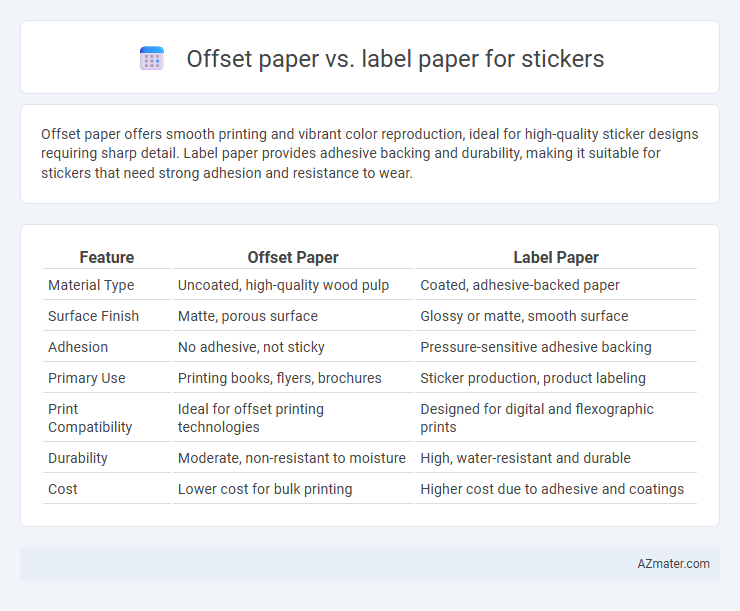Offset paper offers smooth printing and vibrant color reproduction, ideal for high-quality sticker designs requiring sharp detail. Label paper provides adhesive backing and durability, making it suitable for stickers that need strong adhesion and resistance to wear.
Table of Comparison
| Feature | Offset Paper | Label Paper |
|---|---|---|
| Material Type | Uncoated, high-quality wood pulp | Coated, adhesive-backed paper |
| Surface Finish | Matte, porous surface | Glossy or matte, smooth surface |
| Adhesion | No adhesive, not sticky | Pressure-sensitive adhesive backing |
| Primary Use | Printing books, flyers, brochures | Sticker production, product labeling |
| Print Compatibility | Ideal for offset printing technologies | Designed for digital and flexographic prints |
| Durability | Moderate, non-resistant to moisture | High, water-resistant and durable |
| Cost | Lower cost for bulk printing | Higher cost due to adhesive and coatings |
Understanding Offset Paper and Label Paper
Offset paper, made from wood pulp and characterized by its smooth surface and high opacity, is commonly used in offset printing due to its excellent ink absorption and cost-effectiveness. Label paper, designed specifically for adhesive applications, features a pressure-sensitive backing that allows it to stick to various surfaces while maintaining print clarity and durability. Understanding these distinct compositions and functionalities helps in selecting the right paper type for high-quality sticker production, balancing print quality, adhesion, and usage environment.
Key Differences Between Offset Paper and Label Paper
Offset paper offers a smooth, high-quality surface ideal for detailed printing and vibrant color reproduction, making it suitable for premium stickers requiring sharp images. Label paper, designed specifically for adhesive applications, features a sticky backing and varying levels of durability, such as water resistance, to ensure longevity and adherence on diverse surfaces. The key differences lie in offset paper's print quality and texture versus label paper's adhesive properties and functional durability.
Surface Texture and Print Quality Comparison
Offset paper offers a smooth, matte surface texture ideal for detailed graphic designs, producing sharp and clear prints with excellent color accuracy. Label paper, often coated with a glossy or semi-gloss finish, enhances vibrancy and durability, making prints more resistant to smudging and moisture. The choice between offset and label paper directly impacts sticker print quality, with offset favoring fine art prints and label paper suited for vibrant, durable branding.
Adhesive Properties of Label Paper vs. Offset Paper
Label paper features specialized adhesive properties designed for strong, long-lasting adhesion on various surfaces, making it ideal for sticker applications. In contrast, offset paper lacks inherent adhesive qualities and requires external glue or laminating processes to attach stickers securely. The pressure-sensitive adhesive on label paper ensures durability and resistance to peeling, which offset paper cannot inherently provide.
Durability and Lifespan for Stickers
Offset paper offers moderate durability suitable for indoor stickers with a typical lifespan of 1-2 years, but it lacks resistance to moisture and abrasion. Label paper, especially when coated or laminated, provides enhanced durability and water resistance, extending sticker lifespan up to 5 years or more in outdoor or high-use environments. Choosing label paper significantly improves sticker longevity due to its superior resistance to environmental factors and wear.
Cost Analysis: Offset Paper vs. Label Paper
Offset paper for stickers generally offers a lower cost per unit due to bulk manufacturing but may incur higher setup and finishing expenses. Label paper, designed specifically for adhesive applications, often results in higher material costs but reduces waste and labor during production, balancing the overall expense. Analyzing total cost involves weighing offset paper's upfront savings against label paper's efficiency and durability benefits in sticker printing.
Best Printing Techniques for Each Paper Type
Offset paper offers excellent ink absorption and color vibrancy, making it ideal for detailed and high-quality sticker printing using traditional offset printing techniques. Label paper, often coated and adhesive-backed, is best suited for digital or flexographic printing methods that ensure precise ink application and durability on various surfaces. Selecting the appropriate printing technique enhances sticker longevity and visual appeal based on the paper's texture and intended use.
Suitable Applications for Offset and Label Papers
Offset paper is ideal for high-quality, detailed prints such as brochures, posters, and promotional stickers that require a smooth finish and excellent color reproduction. Label paper excels in producing durable, adhesive-backed stickers for product labeling, packaging, and branding due to its strong adhesion and resistance to moisture and abrasion. Choosing offset paper suits indoor applications with intricate designs, while label paper is best for functional, long-lasting stickers exposed to handling or environmental elements.
Environmental Impact and Sustainability
Offset paper used for stickers typically involves higher energy consumption and chemical usage during production, contributing to greater environmental impact compared to label paper, which often incorporates recycled fibers and eco-friendly adhesives. Label paper designed for stickers is more sustainable, frequently marked as FSC-certified or made from biodegradable materials that reduce landfill waste and facilitate composting. Choosing label paper with low VOC inks and water-based coatings further enhances sustainability by minimizing harmful emissions and improving recyclability.
Choosing the Right Paper for Your Sticker Project
Choosing the right paper for your sticker project depends on the desired finish and durability; offset paper offers a smooth, cost-effective surface ideal for indoor use with vibrant print quality, while label paper provides a self-adhesive backing suited for easy application and long-lasting adhesion on various surfaces. Offset paper is best for high-volume printing with sharp image reproduction, but label paper ensures strong adhesion and moisture resistance, making it preferable for outdoor or product labeling stickers. Understanding the printing method, sticker placement, and environmental exposure helps determine whether offset or label paper will deliver optimal results for your sticker project.

Infographic: Offset paper vs Label paper for Sticker
 azmater.com
azmater.com